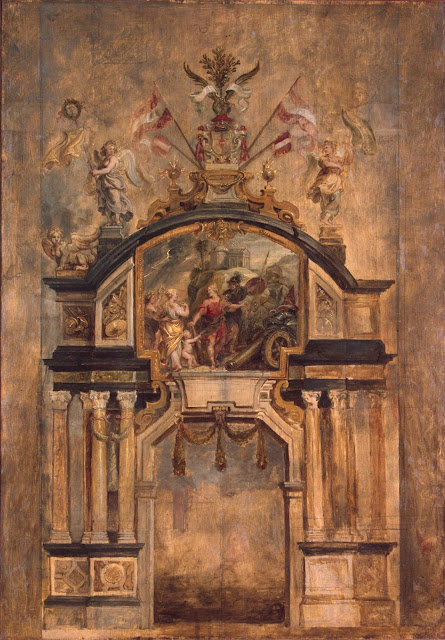 |
| Peter Paul Rubens Cartoon for Arch of Hercules Joyous Entry at Antwerp of Cardinal-Infante Ferdinand 1634 oil on panel, transferred to canvas Hermitage, Saint Petersburg |
The Hermitage in Saint Petersburg owns a set of oil cartoons by Peter Paul Rubens created as designs for the large temporary constructions that greeted the Spanish Regent, Cardinal-Infante Ferdinand, when he enacted the traditional Joyous Entry upon his arrival at Antwerp in the 1630s. These cartoons were acquired in England in the 18th century by agents of Catherine the Great and shipped to Russia. They had formed part of the vast art collection sold following the death of that famously rich and domineering Prime Minister, Sir Robert Walpole (1676-1745).
 |
| Peter Paul Rubens Cartoon for Arch of Ferdinand Joyous Entry at Antwerp of Cardinal-Infante Ferdinand 1634 oil on panel, transferred to canvas Hermitage, Saint Petersburg |
 |
| Peter Paul Rubens Cartoon for Temple of Janus Joyous Entry at Antwerp of Cardinal-Infante Ferdinand 1634 oil on panel, transferred to canvas Hermitage, Saint Petersburg |
 |
| Peter Paul Rubens Scene of Congratulations Joyous Entry at Antwerp of Cardinal-Infante Ferdinand 1634 oil on panel, transferred to canvas Hermitage, Saint Petersburg |
 |
| Peter Paul Rubens Cartoon of Mercury Embarking Joyous Entry at Antwerp of Cardinal-Infante Ferdinand 1634 oil on panel, transferred to canvas Hermitage, Saint Petersburg |
 |
| Francesco Furini Andromeda ca. 1636 oil on canvas Hermitage, Saint Petersburg |
Francesco Furini (1603-1646) trained in his native Florence, but made the crucial pilgrimage to Rome in 1619, where he fell in with a new shadowy style propagated by followers of recently-deceased Caravaggio. Back in Florence, Furini became a successful fresco painter. His easel-works tended toward 'rather morbidly sensuous depictions of the female nude,' according to curators at the National Gallery in London. There is a good supply of just those paintings at the Hermitage, though all but the Andromeda (above) are laboring under old coats of yellowed varnish (an effect formerly called 'patina' and now routinely removed or reduced in most – but not all – museums).
 |
| Francesco Furini The Three Graces 1633 oil on canvas Hermitage, Saint Petersburg |
 |
| Francesco Furini Penitent Magdalene before 1646 oil on canvas Hermitage, Saint Petersburg |
 |
| Francesco Furini Penitent Magdalene before 1642 oil on canvas Hermitage, Saint Petersburg |
 |
| Francesco Furini Penitent Magdalene before 1646 oil on canvas Hermitage, Saint Petersburg |
Adriaen van der Werff (1659-1722), active in Rotterdam, shared some obvious characteristics with his predecessor Furini in Florence – similar pale nudes emerge from similar chiaroscuro (as below). Yet these paintings were definitely less dark three hundred years ago, when new. In many cases, the fashionable concentrations of dark pigment that prevailed in the 17th century have suffered chemical changes over time, darkening well beyond the artists' intentions.
 |
| Adriaen van der Werff Sarah bringing Hagar to Abraham 1696 oil on canvas Hermitage, Saint Petersburg |
 |
| Adriaen van der Werff Lot and his Daughters 1711 oil on panel Hermitage, Saint Petersburg |
 |
| Adriaen van der Werff The Expulsion 1700 oil on panel Hermitage, Saint Petersburg |
 |
| Adriaen van der Werff Self-portrait 1696 oil on panel Hermitage, Saint Petersburg |